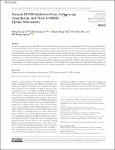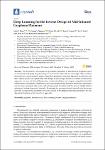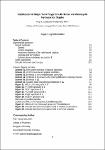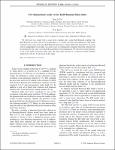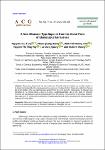Search
Author
- Viet-Thanh Pham (4)
- Tuan Q. Do (3)
- Anh D. Phan (2)
- Chu, Manh Hung (2)
- next >
Subject
- Cosmology and Nongalac... (2)
- General Relativity and... (2)
- Multistability (2)
- 2-NBDG (1)
- next >
Has File(s)
Search Results
Ten active principles (compounds 1-10) have been isolated following protein tyrosine phosphatase 1B (PTP1B) assay-guided fractionation of the methanol extract of the root of Polygonum cuspidatum. The chemical structures of the compounds were characterized mainly by nuclear magnetic resonance (NMR) spectroscopic and physicochemical data. This is the first time that 9,10-anthraquinones (compounds 5-6) have been isolated from P. cuspidatum, and this is the first record of compound 9 from the genus Polygonum. Except for compound 4, all the isolates showed potential inhibitory activity against PTP1B with half-maximal inhibitory concentration IC50 values ranging from 6.3 to 28.9 µM. Furthermore, a kinetic study indicated mixed-competitive inhibition with PTP1B for compounds 2 and 9 and no... |
We theoretically investigate the plasmonic properties of mid-infrared graphene-based metamaterials and apply deep learning of a neural network for the inverse design. These artificial structures have square periodic arrays of graphene plasmonic resonators deposited on dielectric thin films. Optical spectra vary significantly with changes in structural parameters. To validate our theoretical approach, we carry out finite difference time domain simulations and compare computational results with theoretical calculations. Quantitatively good agreements among theoretical predictions, simulations, and previous experiments allow us to employ this proposed theoretical model to generate reliable data for training and testing deep neural networks. By merging the pre-trained neural network wit... |
Compressive sampling (CS) has been commonly employed in the field of magnetic
resonance imaging (MRI) to accurately reconstruct sparse and compressive signals. In a MR image,
a large amount of encoded information focuses on the origin of the k-space. For the 2D Cartesian
K-space MRI, under-sampling the frequency-encoding (kx) dimension does not affect to the
acquisition time, thus, only the phase-encoding (ky) dimension can be exploited. In the traditional
random under-sampling approach, it acquired Gaussian random measurements along the phaseencoding (ky) in the k-space. In this paper, we proposed a hybrid under-sampling approach; the
number of measurements in (ky) is divided into two portions: 70% of the measurements are for
random under-sampling and 30% are for definite un... |
Compression effects on alpha and beta relaxation process of amorphous drugs are theoretically investigated by developing the elastically collective nonlinear Langevin equation theory. We describe the structural relaxation as a coupling between local and nonlocal activated process. Meanwhile, the secondary beta process is mainly governed by the nearest-neighbor interactions of a molecule. This assumption implies the beta relaxation acts as a precursor of the alpha relaxation. When external pressure is applied, a small displacement of a molecule is additionally exerted by a pressure-induced mechanical work in the dynamic free energy, which quantifies interactions between a molecule with its nearest neighbors. The local dynamics has more restriction and it induces stronger effects of c... |
The detection of volatile organic compounds (VOCs) is very important in practical application in breath analysis. Thus, gas sensors based on metal oxide have been fabricated, but they lacked selectivity. One approach to resolve this task is to use array of highly sensitive and selective sensors as an electronic nose. Here we present a gas sensor array of Tin oxide nano-structure use of temperature modulation techniques. A Platinum micro-heater is accompanied with the array gas sensor. The gas sensor array was composing of five single sensors and that single sensor is located at different site from the micro heater and work at different temperatures. The gas sensing properties of the gas array sensors was investigated with VOC gases such as Ethanol, Methanol, Iso-propanol, and Aceton... |
Polyproline II helix (PPII) is one of the secondary structures in proteins that play an important role in various biological processes. In this study, we have developed a new macrocyclization strategy that efficiently reinforces a model tetrapeptide into a PPII structure. We also elucidated some relationships between structural features and PPII stability in this model. This new macrocyclic stapling strategy can serve as a useful chemical tool to manipulate the PPII structure for various applications. |
We will focus on a model with a scalar-vector coupling and a scalar Kalb-Ramond coupling. The Kalb-Ramond two-form is known to be equivalent to a
U
1
gauge one-form in five dimensions. The model with both scalar-vector and scalar Kalb-Ramond interactions is hence effectively equivalent to an action with two independent vector fields. As a result, a new set of spherically symmetric black hole solutions will be presented for the scalar-vector Kalb-Ramond theory in five dimensions. We will show that the presence of the scalar fields and gauge fields affect the black hole structure in a nontrivial manner. Related implications will also be discussed in this paper. |
In this work, chaos is experimentally observed from a circuit, in which the nonlinear element is a real memristor. To the best of our knowledge, this is the first nonlinear circuit with a commercially available memristor (KNOWM memristor), which has been implemented in order to experimentally investigate chaos and phenomena related with it, such as a route to chaos via period-doubling, one-scroll and the well-known double-scroll chaotic attractors. |
Elaeocarpus hainanensis has been used in the Oriental medicine but there are very few studies on its phytochemical profile. Our ongoing research on chemical constituents from Elaeocarpus plants in Vietnam led to the isolation of a new oleanane-type saponin from the aerial part of E. hainanensis. Its structure was identified as 1α-hydroxy-olean-11-oxo-12-en-3-O-β-L-arabinopyranoside (1) on the basis of extensive chemical and spectroscopic analyses including NMR and MS spectra. The occurence of the unique oleananetype saponins in E. hainanensis contributed to impact phytochemical profile associated with chemotaxanomy meaning of the title plant. |
We argue that neutrino mass and dark matter can arise from an approximate B − L symmetry. This idea can be realized in a minimal setup of the flipped 3-3-1 model, which discriminates lepton families while keeping universal quark families and uses only two scalar triplets in order for symmetry breaking and mass generation. This proposal contains naturally an approximate non-Abelian B − L symmetry which consequently leads to an approximate matter parity. The approximate symmetries produce small neutrino masses in terms of type II and III seesaws and may make dark matter long lived. Additionally, dark matter candidate is either unified with the Higgs doublet by gauge symmetry or acted as an inert multiplet. The Peccei-Quinn symmetry is discussed. The gauge and scalar sectors are exactl... |

